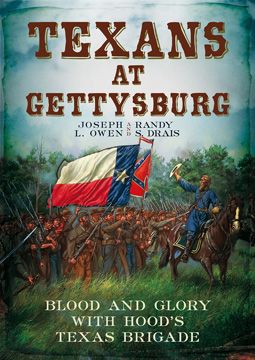Review: “Texans at Gettysburg” by Joe Owen and Randy Drais

 In an army full of storied units, the Texas Brigade certainly stands among the tallest. Their hard work during the Seven Days set a tone they carried with them like the Lone Star through the rest of the war. Their story is inextricably tired to that of the Cornfield at Antietam, and they flooded into the gap in the Federal line at Chickamauga. “Texans always move them,” Lee declared at the Wilderness in May of 1864.
In an army full of storied units, the Texas Brigade certainly stands among the tallest. Their hard work during the Seven Days set a tone they carried with them like the Lone Star through the rest of the war. Their story is inextricably tired to that of the Cornfield at Antietam, and they flooded into the gap in the Federal line at Chickamauga. “Texans always move them,” Lee declared at the Wilderness in May of 1864.
Authors/editors Joseph L. Owen and Randy S. Drais have offered a new contribution to the storied history of these Confederate shock troops, Texans at Gettysburg: Blood and Glory with Hood’s Brigade, a collection of primary source material that tells the Texans’ story at Gettysburg in their own words.
While the accounts are all sourced in the endnotes, the text itself doesn’t offer much context about the sources, which largely consist of hard-to-find newspapers (something I always particularly enjoy). Owen and Drais did an excellent job of curating the clippings and organizing them into an interesting whole.
As editors, they tackle the brigade regiment by regiment—1st, 4th, and 5th Texas and the 3rd Arkansas—offering background information at the start of each section so that readers understand who they’re reading about and where they came from. Beyond that, the editors largely stay out of the way, letting the Texans themselves do the storytelling.
A fifth chapter covers the postwar correspondence of the generals, who continued to fight the battle years after it ended. “I shall ever believe that had I been permitted to turn Round Top mountain,” Gen. John Bell Hood wrote in one such letter, “we would not only have gained that position, but [would] have been able finally to route the enemy.”
Another chapter includes a number of postwar speeches from veterans’ gathering. Here, the writing gets fun (believe it or not) because it lives up to Texas’s reputation for being bigger than life. Try this single sentence from Dr. John O. Scott’s “Battle Flags of Hood’s Brigade”:
Here in this furious tornado of battle, where death held high carnival and huge destruction with giant strides shook the earth beneath, and all creation trembled for the work of the demon of war, in sight of the star-crossed emblem of liberty, glory, patriotism, and honor, which Hood, his famous general, had given him, Colonel Ben F. Carter at the head of his column “on to death and glory dashing,” like the torn and mangled Marshall Lannes at Lobau was hurdled in “the crimson trench of death, no more to rise in arms or shine in war again.”
The final section of the book covers “The Other Texans at Gettysburg” and touches on Texans who fought in other units. “Many soldiers, both Union and Confederate[,] fought at Gettysburg and settled in Texas after the Civil War,” Owen and Drais explain. Individuals with Lone Star connection fought with such varied units as the 17th Mississippi, 10th Alabama, and the 50th Virginia.
Texans at Gettysburg proved to be a useful research aid for me as I worked on Don’t Give an Inch: The Second Day at Gettysburg, which of course was their moment of greatest hazard and renowned during the battle. I suspect other researchers will find it equally useful. Fans of the Texas Brigade—and there are many—will enjoy it as a volume that adds some excellent forgotten accounts to the literature.
Mostly, though, the book stands out as a tremendous labor of love by two men who obviously admire the Texans they write about. I know Joe professionally, and know him to be a staunch keeper of the flame of All Things Texan in the war. In sharing these voices, he does justice to the men I know he admires deeply.
“The only good Texan is a dead Texan ” – General Dan Sickles
is that the same Dan Sickles that demanded ‘Champagne’ when he was operated on?